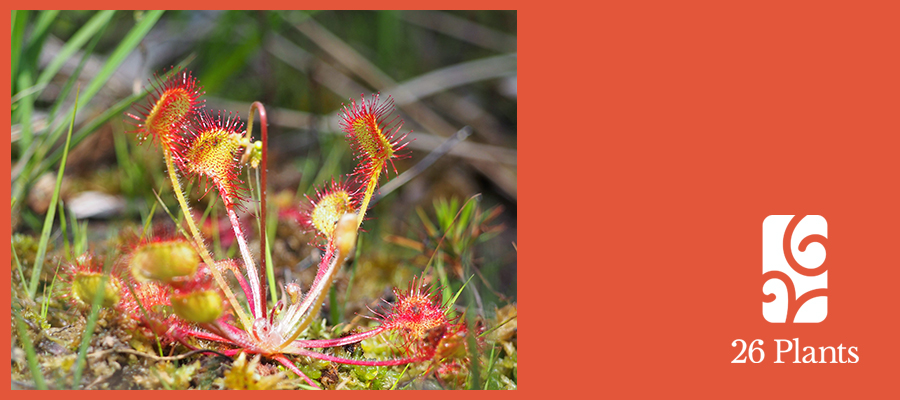Round-leaved sundew
Drosera rotundifolia
Joan Lennon

Carnivory Where You Least Expect It
Sweet unlikely carnivore,
bogged down and
snuggled into sphagnum,
scarcity’s your mother.
What the wet earth can’t supply
you draw from the sky –
small meat,
like midgie, gnat,
the occasional dragonfly.
Lilliputian killer
crowned with scented dew
that noonday sun cannot disperse,
eponymous droplets
that shimmer,
lure and clasp –
your halo of bright blobs
deceives clouds of compound eyes,
entices juicy bodies one by one
and then your tendrils close,
each leaf’s embrace
extracts, repurposes …
Scaled up,
Hollywood would be clamouring –
but instead you remain diminutive,
bogged down and
snuggled into sphagnum,
a sweet unlikely carnivore.
I appreciate bogs. Globally, bogs hold twice the carbon that all our forests store. I have driven past miles of solemn soggy expanse in Scotland’s highlands and been awed. But they are not immediately charismatic.
Bogs are not easy places to live. The soil is acidic and lacking in nutrients, especially nitrogen. It’s adapt or die, and one of the most intriguing adaptations is that of the carnivorous sundew. It gets what it needs not through its roots, from the soil, but from the bodies of insects, which it captures with its leaves.
You have to get your eye in to spot sundews. From a distance, its colours are subtle, the reds softened and the greens muted. It is tiny and low to the ground, and when that ground is boggy, it isn’t always easy to get close. But if you don’t mind wet knees, be prepared for miniature wonders.
The sundew’s leaves are fringed with tendrils, each tipped with a globule of sticky sweet-smelling insect-attracting liquid – what Erasmus Darwin called ‘a pellucid drop of mucilage’. (His grandson Charles was obsessed with sundews and wrote in a letter, ‘I care more about Drosera than the origin of all the species in the world.’) The glue holds the insects as the leaves fold around then, enzymes break down their bodies and nutrients are extracted. In summer, a white flower sits atop a tall stem, to keep pollinators from accidentally becoming lunch.
Over the centuries, we have used different parts of the sundew to treat lung ailments, freckles, warts. The lovelorn called it lustwort because of the way it lured and then held on to the object of its desire. The glistening of its dew under the fiercest sun spoke to the elderly of youth and virility. They called it youthwort and applied liberally. Modern science has confirmed it has cough-suppressing properties, but little to aid with love or longevity. The glue of the sundew, however, has sparked some interesting research into bone-knitting adhesive.
Today, there is an International Carnivorous Plant Society and a Carnivorous Plant Day – first Wednesday in May, should you wish to celebrate. Judith Weir, composer for the coronation, has written a piece for violin and cello that portrays a sundew consuming a fly. In Disney’s Encanto, Isabella sings ‘a river of sundew’.
Whatever it takes to keep bogs and sundews in the public eye. Whatever it takes.
Image: Photo by Agnieszka Kwiecień, under Creative Commons license
